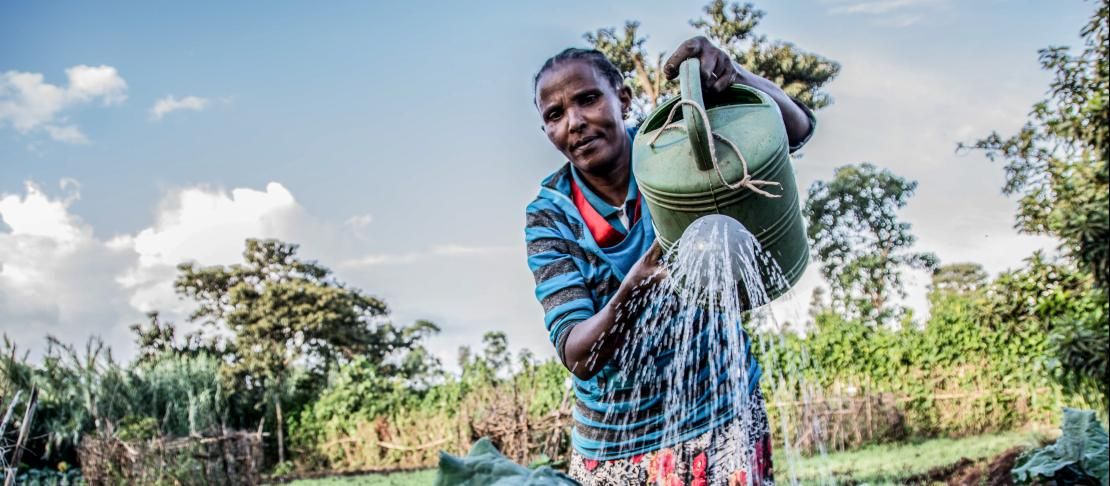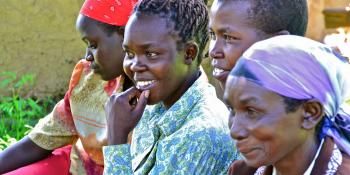Achieving gender parity in African agricultural systems

On International Women’s Day 2016, a webinar highlighted issues central to agricultural development for women in Africa.
“If women had the same access to productive resources as men, they could increase yields on their farms by 20 to 30 percent. This could raise total agricultural output in developing countries by 2.5 to 4 percent, potentially reducing the number of hungry people in the world by 12 to 17 percent,” reads a Food and Agriculture Organization (FAO) report issued in 2011.
The 2016 International Women’s Day (IWD), celebrated on March 8, with the theme of Pledge For Parity, emphasized on the importance of everyone in their spheres of influence to make a concrete commitment to achieve gender equality for women and girls. To commemorate IWD, the Climate and Agriculture Network for Africa (CANA) and partners, among them the CGIAR Research Program on Climate Change, Agriculture and Food Security (CCAFS), held a webinar on achieving gender parity in African agricultural systems linking to the 2015 Sustainable Development Goals (SDGs) and the Paris Climate Agreement. The aim of the webinar was to highlight issues that are central to agricultural development for women in Africa at local, national and international levels.
Drawing on four panelists with expertise in gender, agriculture, food security and nutrition, and rural development, the webinar engaged the participants on opportunities that are available to women that can enhance their contribution and participation in agricultural activities; and critical steps needed to ensure gender parity in Africa’s agriculture and food security.
Listen to a recording of the webinar below:
Local level innovations for women’s empowerment
Dr Jemimah Njuki, Senior Program Officer from International Development Research Center (IDRC), discussed the importance of empowering women in agriculture and increasing their economic opportunities at local level.
“The unique thing in the SDGs compared to Millennium Development Goals is that it looks at women in two contexts first as key to achieving the goals but also in ensuring that growth and development works for women which is in the broader goal of the SDGs of leaving no one behind,” said Jemimah.
She shared successful innovations, drawing from IDRC's work in the region, which can improve household nutrition and reduce women’s hard labor. There have been calls for simple household technologies that can save women’s time and health including affordable mechanized farming equipment such as mechanized thresher that reduces millet and finger millet threshing time by 35% and 40%, respectively; and precooked beans that reduce cooking time from 2-3 hours to 10-15 minutes.
Increasing women leadership at national level
Women’s representation in agricultural science and policymaking is still low in Africa: one out of four scientists is a woman and in science leadership one out of seven science leaders is a woman. Except for Rwanda that has more women than men in their parliament, the number of women in key decision-making positions is still low. African countries should design and implement programs that can enhance leadership and agricultural science skills for women, like the African Women in Agricultural Research Development (AWARD), concluded Jemimah.
#IWD2016 @cgiarclimate_EA webinar. Jemimah Njuki @IDRC_AFRIQUE says gender equality is also about men.
— CGIAR Climate EA (@cgiarclimate_EA) March 8, 2016
Achieving gender parity in the intensive dairy sector
Representing the livestock sector, Katie Tavenner from the International Livestock Research Institute (ILRI) highlighted challenges and opportunities to achieving gender parity in the Kenyan dairy value chain. Tavenner, a Postdoctoral fellow, shared lessons from the successful East African Dairy Development (EADD) project which designed technologies with women’s capacities and labor burden in mind. By engaging with this project, women formed milk cooperatives that give them bargaining power for milk prices, and had their leadership skills enhanced.
“We need to make a business case for gender inclusion as a pathway to getting people to understand the loss of productivity and income that occurs when gender inequalities go unaddressed,” said Tavenner.
Going forward, Kenya is developing Nationally Appropriate Mitigation Actions (NAMAs) for the dairy sector. This process is being supported by a number of partners among them CCAFS scientists based at the World Agroforestry Centre (ICRAF), UNIQUE forestry and land use, ILRI and FAO.
Read more: Nationally Appropriate Mitigation Actions in Kenya’s dairy sector
Improving nutrition in Africa within the context of a changing climate
Transformation of Africa’s agriculture is needed to ensure malnutrition is tackled. According to Tawanda Muzhingi from the International Potato Centre (CIP), it is becoming increasingly clear that protecting women's nutrition, notably during pregnancy and lactation but in fact throughout the lifecycle, is necessary to safeguard the nutrition of infants, children, and indeed future generations. Dr. Muzhingi highlighted the importance of acknowledging the role that women play in agriculture and nutrition in Africa.
“To improve nutrition, we must increase women’s access to education to not only improve their knowledge but also increase their income opportunities. Secondly, access to capital and money to invest in their businesses and agricultural systems is crucial to improving their livelihoods,” said Tawanda.
Opportunities for the youth and girls in agriculture
#IWD2016 @cgiarclimate_ea webinar. @PriscillaAchakp discusses opportunities for youth in agric & climate financing pic.twitter.com/zeFhVFfBv2
— Tez Lore (@tezira) March 8, 2016
According to Priscilla Achakpa, the Executive Director of Women Environmental Programme (WEP) Nigeria, Article 65 of the Paris Agreement presents ample opportunity for youth-led projects and programs. There is a chance for them to access financial support to implement projects. Priscilla highlighted successful youth initiatives such as the Youth Farm (YFarm) Project in Nigeria that could be scaled up to other African countries.
“At the national level we have the national youth councils in most of the African countries that have some kind of laid down action plans of how the countries can integrate youth into national development," said Achakpa. Youth and girls therefore need to actively participate in these councils to ensure their voices are heard.
Key lessons learned are:
- There are opportunities to make a ‘business case’ for gender inclusion during design of climate change adaptation strategies.
- Strengthening women’s access to markets and appropriate technologies that are supported by a favorable policy environment.
- Within the Paris agreement (Article 65), there is ample opportunity for youth to engage with their countries for financial support for youth-led projects and programs.
- Active engagement of women in designing agricultural adaptation measures and decision-making processes at different scales (from farm to national level) will improve women’s leadership, incomes, empowerment and thus increasing their adaptive capacity and resilience.
Access all the presentations on Slideshare below:
Mary Nyasimi is a Gender and Policy Specialist while Solomon Kilungu is Communication Assistant They all work for CCAFS East Africa.



